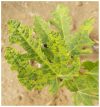High-Throughput Sequencing Identified Multiple Fig Viruses and Viroids Associated with Fig Mosaic Disease in Iraq
- PMID: 39397303
- PMCID: PMC11471924
- DOI: 10.5423/PPJ.OA.04.2024.0068
High-Throughput Sequencing Identified Multiple Fig Viruses and Viroids Associated with Fig Mosaic Disease in Iraq
Abstract
Mosaic is the most common viral disease affecting fig plants. Although the Fig mosaic virus is the leading cause of mosaic disease, other viruses are also involved. High-throughput sequencing was used to assess viral infections in fig plants with mosaic. The genomic DNA and total RNAseq of mosaic-symptomatic fig leaves were sequenced using the Illumina platform. The analysis revealed the presence of fig badnavirus 1 (FBV-1), grapevine badnavirus 1 (GBV-1), citrus exocortis viroid (CEVd), and apple dimple fruit viroid (ADFVd). The FBV-1 and GBV-1 sequences were 7,140 bp and 7,239 bp long, respectively. The two genomes encode one open reading frame containing five major protein domains. The viroids, CEVd and ADFVd, were 397 bp and 305 bp long. Phylogenetic analyses revealed a close relationship between FBV-1 and Iranian isolates of the same species, while GBV-1 was closely related to Russian grapevine badnavirus isolates (Tem64, Blu17, KDH48, and Pal9). CEVd was closely related to other Iraqi isolates, while ADFVd was strongly related to a Spanish isolate. A registered endogenous pararetrovirus, caulimovirus-Fca1, with a size of 7,556 bp, was found in the RNA transcripts with a low expression level. This integrant was also detected in the genomes of the two lines 'Horaishi' (a female line) and 'Caprifig 6085' (a male line). Phylogenetic analyses revealed that caulimovirus-Fca1 was distinct from two other clades of different endogenous virus genera.
Keywords: apple dimple fruit viroid; citrus exocortis viroid; fig badnavirus 1; grapevine badnavirus 1; high-throughput sequencing.
Conflict of interest statement
No potential conflict of interest relevant to this article was reported.
Figures








Similar articles
-
Natural Infection of Pomegranate (Punica Granatum) by Apple Dimple Fruit Viroid.Cells. 2022 Dec 22;12(1):49. doi: 10.3390/cells12010049. Cells. 2022. PMID: 36611843 Free PMC article.
-
Identification and characterization of a viroid resembling apple dimple fruit viroid in fig (Ficus carica L.) by next generation sequencing of small RNAs.Virus Res. 2014 Aug 8;188:54-9. doi: 10.1016/j.virusres.2014.03.026. Epub 2014 Apr 2. Virus Res. 2014. PMID: 24704673
-
A Fig Deal: A Global Look at Fig Mosaic Disease and its Putative Associates.Plant Dis. 2021 Apr;105(4):727-738. doi: 10.1094/PDIS-06-20-1352-FE. Epub 2021 Mar 24. Plant Dis. 2021. PMID: 32936742 Review.
-
First report of the whole‑genome sequence analysis of Fig badnavirus 2 from China.Virus Genes. 2025 Apr;61(2):214-219. doi: 10.1007/s11262-024-02132-0. Epub 2025 Jan 8. Virus Genes. 2025. PMID: 39776408
-
The question of Citrus viroid IV as a cocadviroid.Arch Virol. 2005 Jun;150(6):1059-67. doi: 10.1007/s00705-005-0499-8. Epub 2005 Apr 13. Arch Virol. 2005. PMID: 15821974 Review.
References
-
- Aldhebiani A., Elbeshehy E., Baeshen A., Elbeaino T. Four viruses infecting figs in Western Saudi Arabia. Phytopathol. Mediterr. 2015;54:497–503.
-
- Alisawi O. N. K. Ph.D. thesis. University of Leicester; Leicester, UK: 2019. Virus integration and tandem repeats in the genomes of Petunia.
-
- Alishiri A., Rakhshandehroo F., Jouzani G. S., Shams-Bakhsh M. Exploring the genetic diversity and molecular evolution of fig badnavirus-1 from Iran. J. Plant Pathol. 2018;100:287–299.
-
- Alishiri A., Rakhshandehroo F., Shams-Bakhsh M., Salehi Jouzani G. R. Incidence and distribution of fig badnavirus 1 and mulberry badnavirus 1 on mulberry trees in Iran. J. Plant Pathol. 2016;98:341–345.
LinkOut - more resources
Full Text Sources

